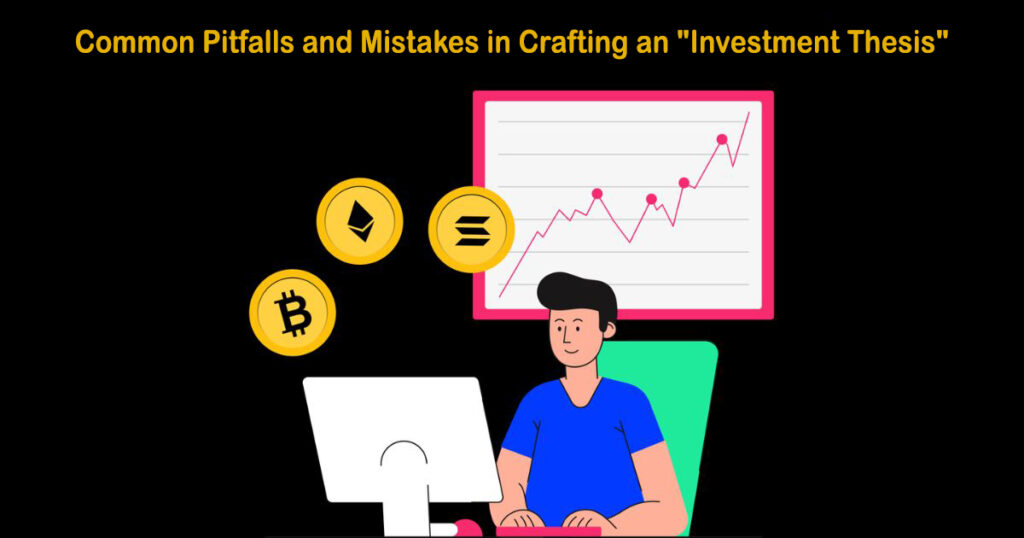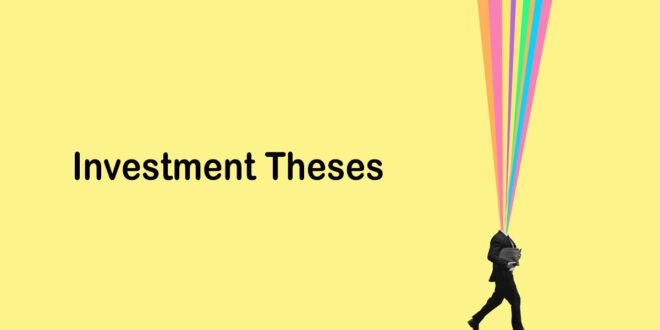I. Welcome to “Investment Thesis”: Introduction
The term “Investment Thesis” is tossed around frequently in the financial world, yet for many, its meaning remains nebulous. With the plethora of information available online, it becomes essential to differentiate between the noise and the genuinely valuable insights.
An Investment Thesis is a coherent and strategic framework that underpins your investment decisions. It acts as a compass in the vast financial wilderness, ensuring that your investment choices are not just reactions to market fluctuations but are rooted in thorough analysis and foresight. Recognizing the importance of having a clear and structured thesis is the first step towards eliminating guesswork and building a resilient investment portfolio.
This blog promises to offer unique and human content that not only demystifies the concept of an investment thesis but also provides a roadmap on how to build one. We’ll start with a deep dive into its definition, understand its pivotal role, and then guide you through the structure of our upcoming posts. All aimed at empowering you with the tools to make informed investment decisions.
So, whether you’re just starting your investment journey or are a seasoned investor looking to refine your strategy, you’re in the right place. Let’s embark on this enlightening journey together, understanding the heart and soul of a well-constructed Investment Thesis!
II. The Fundamentals of an Investment Thesis

A. Purpose: Why Every Investor Should Have an “Investment Thesis”
1. Guiding Decision-Making:
At the heart of every strategic move in the financial realm lies. This comprehensive framework serves as a beacon, ensuring that every investment choice you make is aligned with your long-term objectives and risk tolerance. With entirely unique and human content, this blog underscores the importance of having a roadmap. Without it, navigating the volatile waters of investing becomes akin to sailing without a compass – aimless and risky.
2. Reducing Emotional Investing:
The emotional roller-coaster of market highs and lows can often cloud judgment. An “Investment Thesis” acts as a grounding force, keeping emotions in check. By focusing on data-driven analysis and long-term strategy, it ensures that momentary market sentiments don’t derail your overall financial goals. By sharing insights rooted in human experience and wisdom, we aim to help you cultivate an investing approach that’s less reactive and more reasoned.
3. Providing a Measure for Success:
How does one gauge the effectiveness of their investment decisions? The answer lies within a well-structured “Investment Thesis.” It sets clear benchmarks and objectives, offering a tangible yardstick to assess performance against. With our genuine and unique content, we’ll delve into how having such a measure not only indicates past successes but also guides future refinements in strategy, ensuring continual growth and adaptation in the ever-evolving financial landscape.
B. Components of a robust investment thesis
1. Investment Objectives and Goals:
A strong “Investment Thesis” always starts with clarity. It’s crucial to outline what you aim to achieve financially. Whether it’s wealth preservation, growth, or income generation, having clear objectives anchors your investment decisions, ensuring they align with your aspirations. Through unique and human content, we’ll guide you in defining these foundational pillars.
2. Investment Horizon:
Every “Investment Thesis” requires a timeline. The duration for which you plan to hold an investment plays a pivotal role in shaping your strategies. From short-term trading to long-term holdings, we offer fresh perspectives to help you determine your optimal time frame.
3. Risk Tolerance and Risk Profile:
Investing always involves some degree of risk. A well-constructed “Investment Thesis” helps you identify how much risk you’re comfortable with and ensures that your investments mirror that comfort level. Our genuine content aims to assist you in understanding and crafting a risk profile that reflects your unique financial situation.
4. Macro and Micro Economic Factors:
A comprehensive doesn’t overlook the broader picture. Macro factors like global economic trends and micro factors, such as industry-specific nuances, play crucial roles in shaping investment decisions. We provide an in-depth analysis, blending both unique insights and human experiences, to help you navigate these intricate terrains.
5. Expected Returns and Benchmark Comparison:
An effective “Investment Thesis” also focuses on anticipated outcomes. By setting clear expectations and regularly comparing your returns with industry benchmarks, you can gauge the efficiency of your strategy. Our content delves into crafting realistic expectations and leveraging benchmarks for continuous refinement.
III. Developing Your Personal Investment Thesis

A. Self-assessment: Understanding your financial situation and goals
At the core of a tailored “Investment Thesis” lies an intimate understanding of one’s financial status and ambitions. Firstly, it’s pivotal to snapshot your current assets, liabilities, and ongoing financial commitments. This foundation aids in charting a realistic financial journey. Secondly, crystalizing your future financial aspirations – be it early retirement, philanthropy, or property investments – gives direction to your “Investment Thesis.” Lastly, ensure these financial goals align seamlessly with broader life ambitions, ensuring your monetary endeavors truly serve your life’s purpose. Through unique and human content, we’ll guide you in this introspective journey, making your “Investment Thesis” a genuine reflection of your aspirations.
B. Research: Tools and techniques to gather market intelligence
1. Importance of Diverse Information Sources:
A robust “Investment Thesis” requires a well-rounded view. Drawing from varied information sources eliminates blind spots and biases. Our content, rich in unique insights, underscores the value of a diverse research approach, ensuring comprehensive and objective financial strategies.
2. Evaluating Market Trends:
Understanding the pulse of the market is key to a successful “Investment Thesis”. Market trends, often volatile, offer clues about potential investment directions. Through our human-centric approach, we help decode these trends, enabling you to navigate the investment landscape with confidence.
3. Industry Reports and Expert Opinions:
For a nuanced “Investment Thesis”, delving into industry-specific reports and expert perspectives is invaluable. They provide detailed insights often missed in broader market studies. We stress the importance of these in-depth analyses, guiding you to harness their potential for a sharper investment viewpoint.
C. Synthesis: Merging personal goals with market insights
In the world of investing, striking a balance between personal aspirations and market realities is a delicate dance. At the heart of this alignment is the “Investment Thesis.” It’s not just about chasing market trends; it’s about weaving those trends into the fabric of your individual financial dreams. To craft a truly impactful “Investment Thesis,” one must ensure their strategies resonate with both their personal objectives and the market’s heartbeat. Our content, steeped in unique insights and human experiences, champions this synthesis. By marrying personal goals with rich market intelligence, we guide you in sculpting an “Investment Thesis” that is both personal and pragmatic, grounded yet aspirational.
D. Iteration: The importance of updating your thesis over time
In the dynamic landscape of investing, static strategies often falter. Central to the longevity and success of an “Investment Thesis” is its adaptability. As markets evolve, personal goals shift, and global events unfold, the need to revisit and refine your “Investment Thesis” becomes paramount. By iterating, you ensure your financial roadmap remains relevant and resonant. Our content, deeply rooted in unique and human perspectives, underscores this fluidity. Embracing change, we emphasize the periodic reassessment of your thesis. Through iteration, your “Investment Thesis” can morph, adapt, and thrive, mirroring the ever-changing nuances of both the market and personal life.
IV. Common Pitfalls and Mistakes in Crafting an “Investment Thesis”

1. Confirmation Bias:
A perilous trap many fall into is confirmation bias within their “Investment Thesis”. This involves gravitating solely towards data aligning with pre-existing beliefs, leading to skewed strategies. Our unique, human-driven content emphasizes critical thinking and diverse research to challenge and refine one’s biases, ensuring a more holistic and balanced investment approach.
2. Over-optimism or Pessimism:
Emotions, when unchecked, can cloud the clarity of an “Investment Thesis”. Over-optimism may blind investors to risks, while excessive pessimism can lead to missed opportunities. We shed light on maintaining an objective stance, ensuring emotions enrich, not distort, your investment narrative.
3. Neglecting to Revisit and Adjust:
An “Investment Thesis” is a living document. Failure to periodically reassess and recalibrate it poses significant risks. With dynamic markets and evolving personal goals, a static thesis quickly loses relevance. Through our authentic content, we stress the importance of iteration, ensuring your thesis remains agile and pertinent.
4. Overcomplicating the Thesis:
While in-depth analysis is vital, overcomplicating your “Investment Thesis” can hinder actionable insights. Striking a balance between depth and simplicity is crucial. We guide you to discern essential components from the noise, advocating for a thesis that is both comprehensive and comprehensible.
V. Real-life Examples of Successful Investment Theses
Highlighting Renowned Investors and Their Strategies in the Context of an “Investment Thesis”
1. Warren Buffet’s Value Investing Approach:
Warren Buffet, often dubbed the “Oracle of Omaha”, champions value investing as the cornerstone of his “Investment Thesis”. This method revolves around identifying undervalued stocks that possess intrinsic value, aiming for long-term appreciation. Buffet’s emphasis on fundamentals over speculation, and patience over immediate gratification, sets his strategy apart. Our unique content delves into this philosophy, elucidating how understanding the real worth of an investment, beyond market fluctuations, can lead to sustainable wealth creation.
2. Ray Dalio’s Principles on Diversification:
Ray Dalio’s “Investment Thesis” underpins the importance of diversification. He believes that no single investment or strategy guarantees success. Instead, by spreading investments across varied assets and strategies, one can mitigate risks and capitalize on market opportunities. Dalio’s principles emphasize that a well-diversified portfolio can weather market storms better than a concentrated one. Through our human-centric approach, we offer insights into crafting a diversified thesis, harmonizing both risk and reward.
3. Cathie Wood’s Focus on Disruptive Innovation:
Cathie Wood, the visionary behind ARK Invest, anchors her “Investment Thesis” on disruptive innovation. She bets on companies that challenge the status quo, leveraging groundbreaking technologies or business models. Wood believes that these disruptors, though often perceived as high-risk, hold the potential for exponential returns in the long run. Our content, rich in unique perspectives, explores this forward-thinking approach, guiding readers to recognize and invest in the game-changers of tomorrow.
VI. Tips for Testing and Validating Your “Investment Thesis”
A. Backtesting:
Analyzing Historical Data for Insights:
The adage, “History often repeats itself,” rings especially true in investments. Backtesting, a critical component of a sound “Investment Thesis,” involves scrutinizing historical market data to gauge how a strategy might have performed in the past. By analyzing these trends, one can gain invaluable insights into potential pitfalls and success markers. Our unique content delves deep into the nuances of backtesting, providing a lens to view the future through the prism of the past.
B. Peer Review:
Seeking Feedback from Trusted Advisors or Investment Groups:
An objective, external perspective can be the litmus test for any “Investment Thesis”. Seeking peer reviews from seasoned investors, trusted advisors, or investment groups introduces a fresh lens, often catching oversights and biases. This collaborative approach not only refines your strategy but also nurtures a culture of shared learning. Through our human-centric narratives, we underscore the power of collective wisdom in fortifying your investment blueprint.
C. Flexibility:
Adjusting the Thesis Based on Unforeseen Market Changes:
In the unpredictable world of investments, rigidity can be detrimental. A resilient “Investment Thesis” is one that evolves with the ever-shifting market landscapes. Embracing flexibility allows investors to pivot when unforeseen changes surface, turning potential challenges into opportunities. Our authentic content champions this adaptability, emphasizing the need for agility in the face of market uncertainties.
D. KPIs and Metrics:
Setting Clear Measures to Assess Performance:
Without clear benchmarks, gauging the efficacy of an “Investment Thesis” becomes nebulous. Key Performance Indicators (KPIs) and other relevant metrics serve as compasses, offering tangible measures to assess your strategy’s performance. By setting, monitoring, and iterating based on these metrics, you can ensure your investment journey stays on course. Our unique insights shed light on the art of setting and interpreting these vital signposts, steering your “Investment Thesis” towards success.




